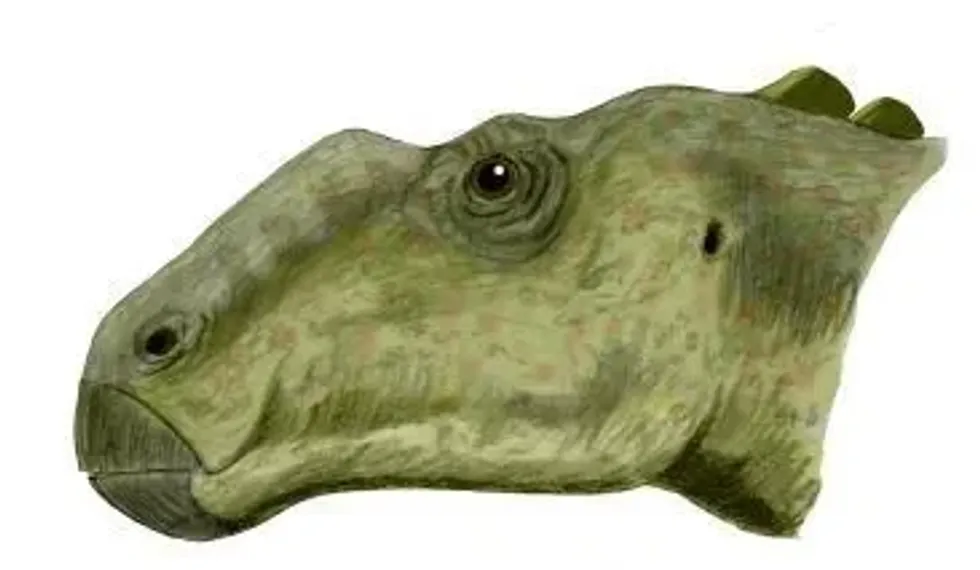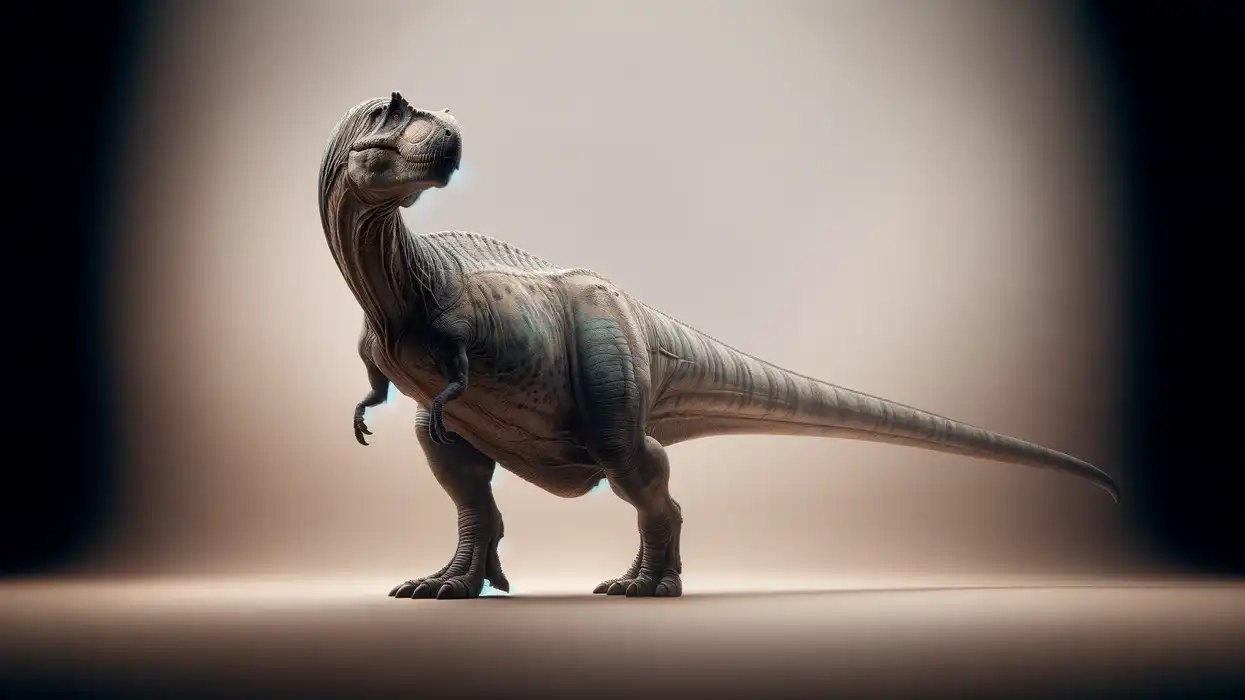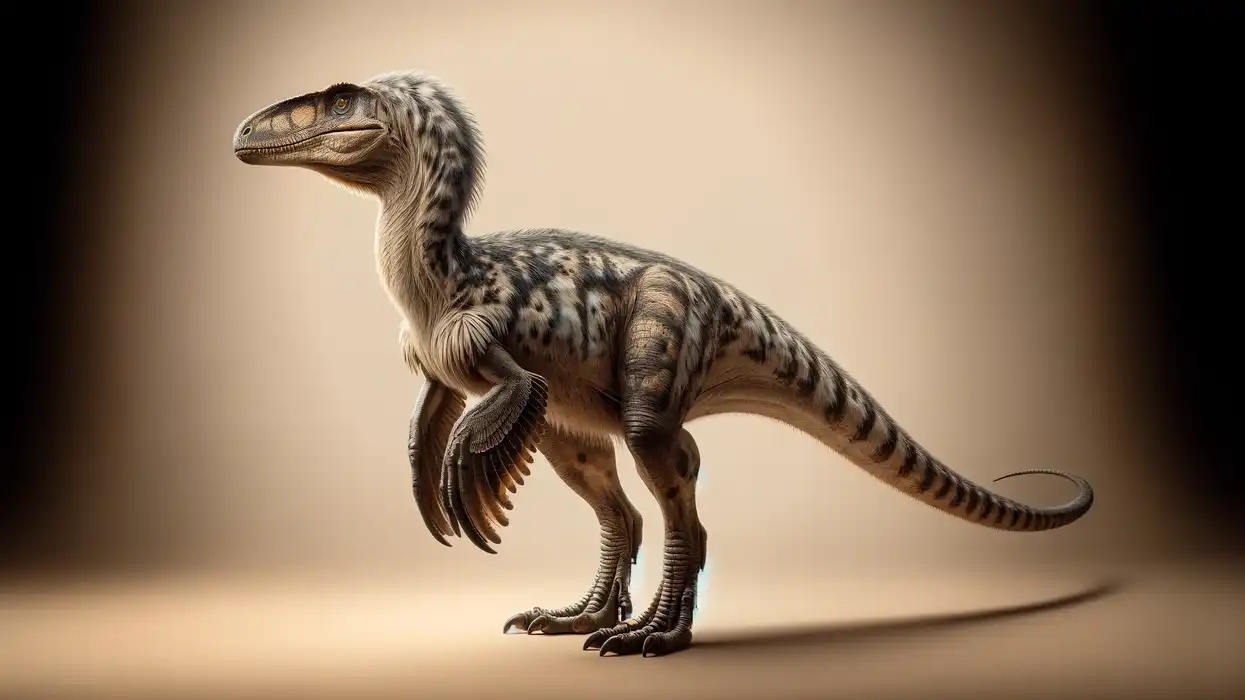The Gryposaurus was a Saurolophine dinosaur that existed during the Late Cretaceous period and may have become extinct during the Late Campanian stage, 75 million years ago.
Fossil records of this dinosaur, which include multiple skeletons and skin impressions, have helped scientists form a complete description of the three members under this genus. The name 'Gryposaurus' meaning 'hooked-nosed lizard', was given to these dinosaurs to mark their characteristic nose arch, which is one of their most special features.
The fossil records of Gryposaurus have been excavated from Dinosaur Park Formation, Alberta, Canada, Kaiparowits Formation, Southern Utah, USA, and Two Medicine Formation, Montana, USA.
Gryposaurus had pyramidal scales on its body and multiple teeth that helped it in grinding the plants it ate. This dinosaur often referred to as being 'Roman nosed', probably lived in herds and invested in parental care for its young.
Its habitat usually had a river and sufficient vegetation for the dinosaur to feed on. In Utah, their ecosystem consisted of ponds, swamps, and lakes, as well. Gryposaurus probably had a massive weight of around 5 t (4536 kg), making it quite a heavy dinosaur of its time.
To learn more about Gryposaurus, keep reading! You can also check out Ledumahadi and Pterodaustro.
Gryposaurus Interesting Facts
How do you pronounce 'Gryposaurus '?
The pronunciation of the name Gryposaurus is 'Grip-o-sore-us'.
What type of dinosaur was a Gryposaurus?
Members of the genus Gryposaurus were Hadrosaurid dinosaurs belonging to the family Hadrosauridae. They are also referred to as Saurolophine dinosaurs due to their presence in the sub-family of Saurolphinae.
In which geological period did the Gryposaurus roam the Earth?
The three species of Gryposaurus roamed the Earth 80-75 million years ago. This era corresponds to the Late Santonian and Campanian stages of the Late Cretaceous period.
When did the Gryposaurus become extinct?
This dinosaur may have become extinct during the Late Campanian stage of the Late Cretaceous itself.
Where did a Gryposaurus live?
Fossils belonging to the three species of Gryposaurus have been collected from three different locations in North America.
The dinosaur assigned as type species, Gryposaurus notabilis (Lambe, 1914), was recovered from the Dinosaur Park Formation of Alberta, Canada. This Formation was right along the Red Deer River.
Gryposaurus latidens skeletons were collected from Two Medicine Formation in Montana, in the USA.
Lastly, fossil specimens belonging to Gryposaurus monumentensis were discovered from the Kaiparowits Formation, located in southern Utah of USA.
Hence, it is safe to assume that these dinosaurs were endemic to North America.
What was a Gryposaurus's habitat?
The description of the habitat of these hadrosaurs is undoubtedly fascinating. In Utah, their ecosystem was a floodplain, which consisted of lakes, ponds, swamps, and was surrounded by highlands. It is estimated that these dinosaurs preferred habitats with a river, so that may have been a consistent setting for the ecosystems of the three different species.
Who did a Gryposaurus live with?
It has been theorized that members of the Gryposaurus genus may have lived in herds, similar to herbivorous mammals of present times.
How long did a Gryposaurus live?
The exact lifespan of a Gryposaurus is yet to be ascertained. They could have lived for about 25 years, which is considered to be the average longevity of hadrosaurs.
How did they reproduce?
Like any other dinosaur, members of this genus reproduced by laying eggs. There may have been the presence of parental care among these dinosaurs. Evidence collected from Canada and Montana suggests that members of the Hadrosauridae group nested in colonies, similar to many birds of present times.
Gryposaurus Fun Facts
What did a Gryposaurus look like?

All the species of Gryposaurus were duck-billed in nature, with a long, narrow skull and protruding snout. Instead of hollow head crests, these dinosaurs were provided with a prominent lump-like structure that was placed in front of the eyes and had a considerable height.
Some of the skulls had the nasal arch with a rough texture, leading scientists to believe this narrow arching nasal hump may have been covered by keratin.
The three species of Gryposaurus of this duck-billed dinosaur have distinctive appearances, as studied from their fossil remains.
The type species Gryposaurus notabilis (Lambe, 1914) had various kinds of scales on its body, which consisted of ridged, pyramidal, and limpet-shaped scutes. Each of these measured 1.5 in (3.8 cm) or more. These scutes were present on the tail and flank.
The body and neck had polygonal scales, which appeared uniform visually. Lastly, they had pyramidal scales that ran along the length of their spine in a single row.
This information related to the scales of this species was deduced from a well-preserved fossil of skin impressions. The nasal arch in G. notabilis was larger and closer to the eyes. Its forearms were longer, as well.
In the case of Gryposaurus monumentensis, the front of the beak had a steeper upward angle. The skull of G. monumentensis was more robust in nature.
Gryposaurus latidens was the most primitive species among the three, with lesser developed teeth and a forward nasal arch.
How many bones did a Gryposaurus have?
Though the exact number of bones of this dinosaur with a 'Roman nose' has not yet been ascertained, a substantial amount of bones have been recovered to give us a picture of the Gryposaurus skeleton. Some of the bones of this saurolophine to be discovered are skull bones, parts of vertebrae, ribs, femora, tibia, chevrons, and ribs.
Interestingly, there are 10 discovered complete skulls and 12 fragmentary skulls belonging to the type species.
Additionally, there are skeletons belonging to several individuals of the G. latidens group. The fossil remains belonging to Gryposaurus monumentensis consisted of a partial skull and skeleton.
How did they communicate?
The narrow arching nasal hump in Gryposaurus may have aided it in communication. Due to the estimated presence of air sacs on both sides of this hump, it is theorized that the dinosaurs used their nasal arch for visual and audible forms of communication.
How big was a Gryposaurus?
The length of a Gryposaurus was around 30 ft (9 m), while its height was around 8.2 ft (2.5 m). The Gryposaurus dinosaur was slightly larger than Protohadros, which probably fell in the range of 23-26 ft (7-8 m) in length.
How fast could a Gryposaurus move?
Gryposaurus was bipedal or quadrupedal in nature, with evidence suggesting these dinosaurs got on their hind legs while reaching for vegetation to feed on. Similar to other hadrosaurid members, the Gryposaurus may have been slow-moving, as well.
How much did a Gryposaurus weigh?
Gryposaurus was quite a big dinosaur, probably weighing around 5 t (4536 kg).
What were the male and female names of the species?
No sex-specific names exist for the male and female hadrosaurs of this species.
What would you call a baby Gryposaurus?
A baby Gryposaurus would be known as a hatchling.
What did they eat?
These dinosaurs of the Cretaceous era were herbivores. Their teeth aided them in grinding the plant material. The plants estimated to have been in their diet range from soft aquatic plants to tough terrestrial plants.
How aggressive were they?
Given the herbivorous nature of this duck-billed dinosaur, it is highly probable that they were not aggressive in nature. In fact, they may have lived in herds in order to have better defense against predators.
Did you know...
A new species of Gryposaurus named Gryposaurus alsatei was discovered from the Javelina Formation in Texas. However, the validity of this dinosaur species is yet to be confirmed.
Some of the synonyms of Hydrosaurus notabilis are Kritosaurus incurvimanus, Kritosaurus notabilis, and Hadrosaurus notabilis.
What do you mean by the term Gryposaurus?
The term 'Gryposaurus', meaning 'hooked-nosed lizard', has an interesting history behind it. This name was an indicator of the unique nasal structure present in these dinosaurs, which is often referred to as being similar to a 'Roman nose'. The name was given by Lawrence Lambe in 1914.
What climate did Gryposaurus live in?
Gryposaurus existed during the Late Cretaceous period when the climate was considerably wet and humid. So, they may have witnessed substantial precipitation, along with rising levels of moisture in the air and higher temperatures.
Here at Kidadl, we have carefully created lots of interesting family-friendly dinosaur facts for everyone to discover! Learn more about some other creatures from our Dryptosaurus facts, or Kosmoceratops fun facts for kids.
You can even occupy yourself at home by coloring in one of our free printable Mesozoic coloring pages.
Main image by Nobu Tamura.









